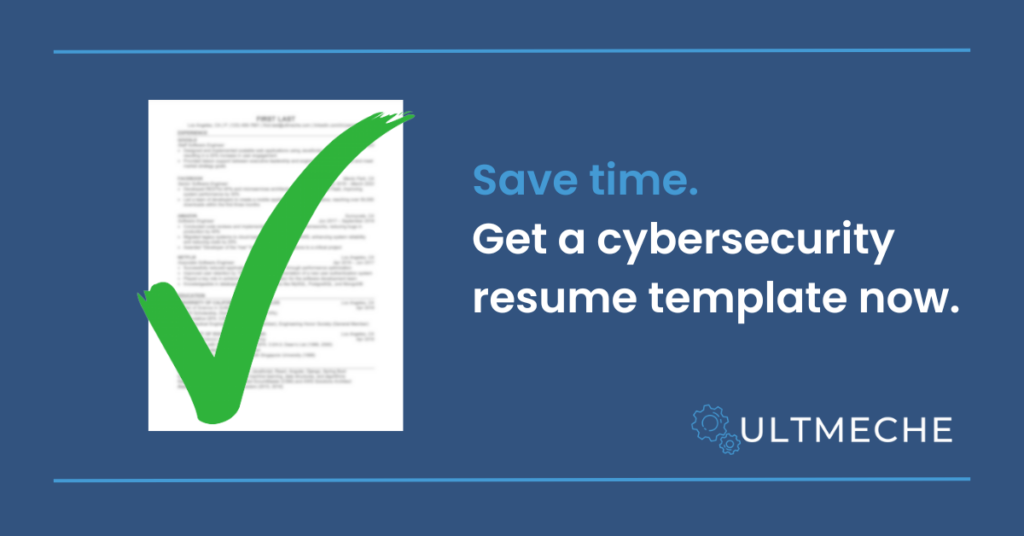Standing out in a competitive applicant field isn’t easy. A good cybersecurity resume template can be the difference between securing an interview and seeing your resume fall to the bottom of the pile.
So what is it that separates an average resume from an exceptional one?
This simple guide will take you through the process of building an effective cybersecurity resume template step by step. When you’re done, you’ll have a polished, customizable resume that showcases your expertise and helps you land your next role.
Short on time? Download a premium cybersecurity resume template here.

Why Is A Tailored Cybersecurity Resume Template Important?
Cybersecurity professionals are tasked with protecting sensitive data, preventing cyber threats, and ensuring system integrity. With such high-stakes responsibilities, employers want candidates who not only have the technical skills but also demonstrate a strong track record of success.
Having a flexible, customizable resume template allows you to tailor your application to each job, ensuring you align with the specific needs of each employer.
Writing Your Cybersecurity Resume Template
Let’s dive straight into creating the perfect resume template for senior cybersecurity roles.
Step 1: Start with a Strong Structure
Before you begin writing, it’s important that your format is right for hiring managers.
A clear and professional structure is the foundation of any great resume. It ensures your qualifications and experience are easy to read and understand and all information can be scanned properly by the applicant tracking system (ATS).
Tips for Formatting Your Cybersecurity Resume
- Professional Design: Stick to a clean and simple layout. Avoid using complicated designs or graphics.
- Readable Fonts: Professional fonts like Arial or Calibri are the preferred choices for resumes. Use consistent font sizing throughout and be consistent with headings and body text.
- Logical Organization: Divide your resume into clear sections with headings like Experience, Skills, and Education. This helps recruiters find the information they need quickly.
- Reverse Chronological Order: Highlight your most recent and relevant roles first. These are usually your most senior positions or most advanced qualifications.
- File Type: Save your resume as a PDF to maintain formatting and readability across devices.
- Bullet Points: Use concise bullet points throughout your resume to outline your accomplishments and responsibilities.
- Preferred Formats: Some tech companies prefer specific formats for resumes, like the Harvard resume format or Google XYZ structure.

Step 2: Contact Information
Your contact details should always be at the top of your resume and be easy to read. Include the following information:
- Full Name: Make sure your full name is prominently displayed.
- Phone Number: Provide a reliable contact number.
- Professional Email Address: Use a professional email like firstname.lastname@email.com.
- LinkedIn Profile: If you have a well-maintained LinkedIn profile, include it to give employers further insight into your professional background.
Step 3: Highlight Your Cybersecurity Experience
Your professional experience is the core of your resume. Use an Experience section to showcase your technical expertise, problem-solving abilities, and achievements.
How to Format Your Experience Section
- Company Details: Include the name and location of the employer.
- Job Title: Clearly state your role (e.g., Cybersecurity Analyst, Penetration Tester, SOC Engineer).
- Employment Dates: Use the month and year where possible.
- Key Responsibilities: Highlight any key responsibilities relevant to the job you’re applying for.
Tip: For the template you may want to write many points that you can add or remove as you tailor your resume for each company.
- Achievements: Use metrics to show the impact of your work (e.g., “Reduced phishing attack incidents by 30% through improved employee training”).
Experience Resume Example
XYZ Corporation – Cybersecurity Analyst
New York, NY | May 2020 – Present
- Developed and implemented advanced threat detection strategies, reducing response times by 40%.
- Conducted penetration testing to identify and resolve system vulnerabilities, ensuring compliance with ISO 27001.
- Collaborated with cross-functional teams to design and implement a company-wide zero-trust security framework.
Step 4: Education
Education is a key section of your resume for many cybersecurity roles, especially those requiring technical knowledge or certifications.
What to Include:
- Institution Name: Include the full name of the university or training centre.
- Degree or Certification: Outline the name of your qualifications, such as a Bachelor’s in Cybersecurity or Master’s in Information Systems.
- Graduation Date: Include the month and year of graduation.
- Relevant Coursework or Projects: Highlight projects that demonstrate your expertise in areas like network security, cryptography, or ethical hacking. This may be particularly valuable if you have limited experience.
Education Resume Example
University of California, Berkeley
Bachelor of Science in Cybersecurity | May 2018
- Relevant Coursework: Network Security, Cryptography, Ethical Hacking
- Academic Achievements: Dean’s List, Cybersecurity Club President
Step 5: Skills, Certifications, and Additional Achievements
In cybersecurity, technical skills and certifications are crucial for standing out. This section allows you to demonstrate your qualifications and skills beyond your work and education.
- Technical Skills: List tools, software, and frameworks you’re proficient in.
- Certifications: Include industry-recognised certifications such as Certified Information Systems Security Professional (CISSP), Certified Ethical Hacker (CEH), or CompTIA Security+.
- Awards: Highlight any recognitions or achievements in your field.
- Languages: Mention any programming or spoken languages relevant to global cybersecurity roles.
Skills And Achievements Resume Example
- Technical Skills: Proficient in Python, JavaScript, Wireshark, Metasploit, Nessus, Splunk, and Palo Alto Firewalls
- Certifications: CISSP, CEH, CompTIA Security+, AWS Certified Security – Specialty
- Languages: Fluent in English and Spanish; Intermediate in Mandarin
- Awards: Winner, National Cybersecurity Competition (2022)
Create Your Cybersecurity Resume Template Today
Creating a great resume takes some time, particularly if you’re properly adapting it for each role.
A template can be the perfect solution to make sure the quality you’re submitting doesn’t dip. A flexible and professional template that highlights your skills, certifications, and achievements effectively can help you to land your dream role.
Whether you’re targeting roles in government agencies, financial institutions, or tech companies, a well-crafted resume will help you make a lasting impression on hiring managers.

Don’t wait—download your professional cybersecurity resume template now and take the first step toward your next career opportunity.
About the author

Mollie Buttery
Writer | SEO | Articles & Blog Posts | Social Media
Mollie supports ULTMECHE through website growth, social media, SEO, and also other digital marketing tricks. Mollie has 10+ years experience of in house and freelance marketing experience in industries such as Finance, Law, SAAS, Automotive, Building Services, Commerce, and more. Some of her favorite writing topics consist of sports and finance. Mollie has been key to the growth of ULTMECHE’s SEO and digital marketing efforts.

1 thought on “The Cybersecurity Resume Template To Help You Land Your Next Role”